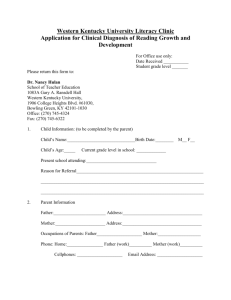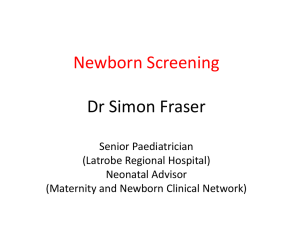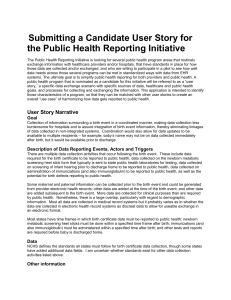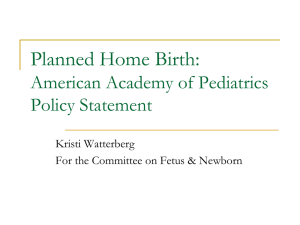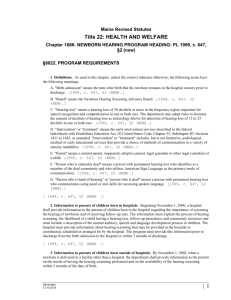Sample OAE Birth Unit Policy
advertisement
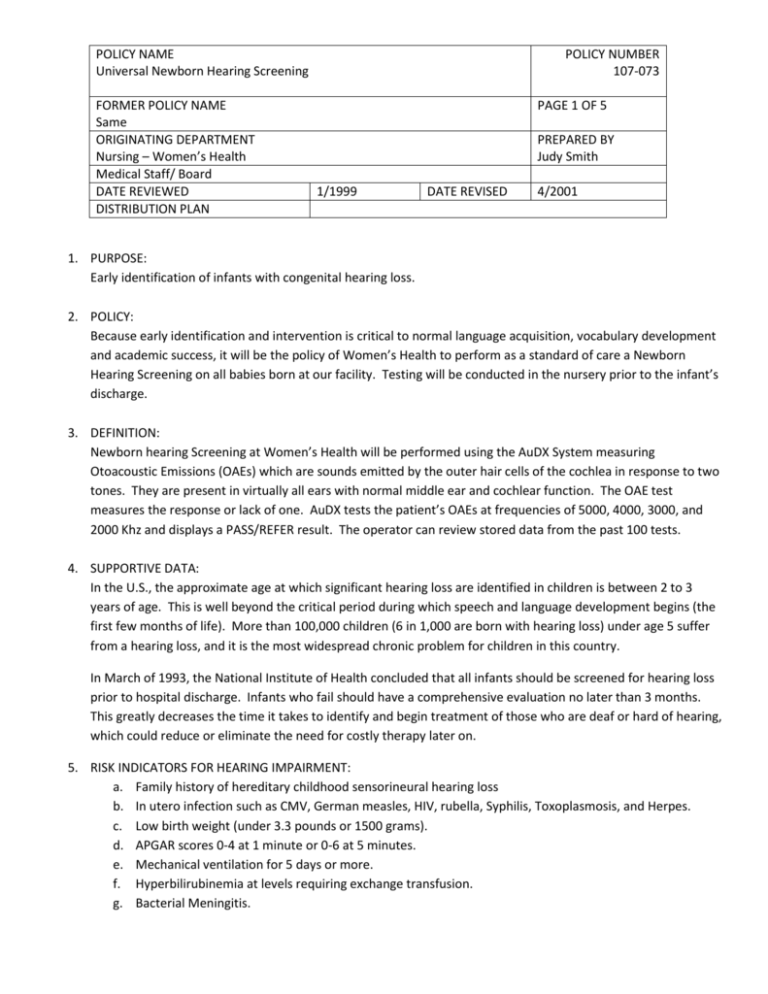
POLICY NAME Universal Newborn Hearing Screening FORMER POLICY NAME Same ORIGINATING DEPARTMENT Nursing – Women’s Health Medical Staff/ Board DATE REVIEWED DISTRIBUTION PLAN POLICY NUMBER 107-073 PAGE 1 OF 5 PREPARED BY Judy Smith 1/1999 DATE REVISED 4/2001 1. PURPOSE: Early identification of infants with congenital hearing loss. 2. POLICY: Because early identification and intervention is critical to normal language acquisition, vocabulary development and academic success, it will be the policy of Women’s Health to perform as a standard of care a Newborn Hearing Screening on all babies born at our facility. Testing will be conducted in the nursery prior to the infant’s discharge. 3. DEFINITION: Newborn hearing Screening at Women’s Health will be performed using the AuDX System measuring Otoacoustic Emissions (OAEs) which are sounds emitted by the outer hair cells of the cochlea in response to two tones. They are present in virtually all ears with normal middle ear and cochlear function. The OAE test measures the response or lack of one. AuDX tests the patient’s OAEs at frequencies of 5000, 4000, 3000, and 2000 Khz and displays a PASS/REFER result. The operator can review stored data from the past 100 tests. 4. SUPPORTIVE DATA: In the U.S., the approximate age at which significant hearing loss are identified in children is between 2 to 3 years of age. This is well beyond the critical period during which speech and language development begins (the first few months of life). More than 100,000 children (6 in 1,000 are born with hearing loss) under age 5 suffer from a hearing loss, and it is the most widespread chronic problem for children in this country. In March of 1993, the National Institute of Health concluded that all infants should be screened for hearing loss prior to hospital discharge. Infants who fail should have a comprehensive evaluation no later than 3 months. This greatly decreases the time it takes to identify and begin treatment of those who are deaf or hard of hearing, which could reduce or eliminate the need for costly therapy later on. 5. RISK INDICATORS FOR HEARING IMPAIRMENT: a. Family history of hereditary childhood sensorineural hearing loss b. In utero infection such as CMV, German measles, HIV, rubella, Syphilis, Toxoplasmosis, and Herpes. c. Low birth weight (under 3.3 pounds or 1500 grams). d. APGAR scores 0-4 at 1 minute or 0-6 at 5 minutes. e. Mechanical ventilation for 5 days or more. f. Hyperbilirubinemia at levels requiring exchange transfusion. g. Bacterial Meningitis. Policy Name: Universal Newborn Hearing Screening (Continued) Policy Number: 107-073 Page 2 of 6 6. EQUIPMENT: a. AuDX System b. Probe cable connector with flexible tubing intact c. Clean ear tip of appropriate size for newborn (Tree tip single lumen d. Initial Newborn Hearing Screening Log e. “Dear Dr.” form f. “A Sound Beginning for your Baby” brochure g. “Guide By Your Side Follow through” brochure 7. ENVIRONMENT AND PATIENT PREPARATION: a. Quiet nursery or other room b. Sleeping or quiet baby c. Ideal time (between 2200 and 0600) ½ hour pc. d. Swaddle the baby in a blanket to try to keep movement at a minimum or baby may be held during the screening. Placing the infant on its side can facilitate screening. With the test ear facing up, the probe is more likely to remain in the ear canal for the duration of the test. e. Clip the probe cord to the infant’s blanket with enough slack so that it is not pulling down on the probe. f. If the infant is set up for a screening and he/she remains active, hold test until the baby quiets. 8. PROCEDURE: a. Perform initial test on infant about 12hours old to allow time for retesting one time prior to discharge in the event of a “REFER” result. b. Prepare infant as described above. c. Perform AuDX test according to manual instructions (see page 6 of Policy). d. Log test # (e.g. 1089-L) in the Newborn Log. e. Log results. f. Follow Algorithm (page 5) for proper procedure for PASS or REFER results. g. A charge for this screening will be done on a non-stickered charge sheet. This sheet is to be generated 1 time for an inpatient charge and 1 time for each visit as an outpatient. 9. QUALIFIED HEARING SCREENING EXAMINERS: The entire nursing staff will be trained with the AuDX system by the Hearing Screening coordinator. The staff will follow the Policy and Procedure. Staff will participate in an annual competency evaluation. 10. “PASS” RESULTS (See Algorithm page 4): a. For a PASS result to display, three of the test frequencies must meet the response conditions defined for a pass for each ear. This is done automatically. b. Document results in the Electronic Medical Record (EMR), in the newborn hearing log and on the Metabolic Screening Card. c. If both ears PASS, give parents the “Sound Beginning for your Baby” with results recorded inside. d. Fill out the Dear Dr. form. Enter any known risk indicators. e. Forward copy of “Dear Dr.” form to M.D. Original goes in EMR. Policy Name: Universal Newborn Hearing Screening (Continued) Policy Number: 107-073 Page 2 of 6 11. “REFER” RESULTS (See Algorithm page 4) a. If one or both ears “REFER” repeat test on both ears as near to discharge as possible. b. If the second screen (final screen) results in a “PASS” in both ears, follow the instructions above. c. If the final screen results in a “REFER” result again – environment was conducive and baby cooperative – initiate Newborn Hearing Log, “Dear Dr. Form”, and document in the EMR d. Forward copy of “Dear Dr.” form to M.D. Original goes in EMR. e. Schedule outpatient rescreening at The Birth Center on the Discharge Instructions for 2 to 4 weeks (ASAP after routine newborn visit with M.D.). f. Give “Guide By Your Side Follow-through Card” with results and follow-up appointment recorded to parents. g. Enter re-screen appointment on desk calendar. h. Initiate Outpatient Follow-up Rescreening Log. 12. 2 TO 4 WEEK RESCREENING: a. To be done in the Exam Room in Women’s Health as an Outpatient visit. b. Repeat test as above on both ears. c. Report test results per phone to M.D. if “REFER” results obtained. d. Document results on the Outpatient Follow-up Rescreening Log to be recorded by the Unit Coordinator in WE-TRAC. e. If “PASS” result, fill out the “Outpatient Newborn Hearing Rescreening Dear Dr. Form” and forward copy to M.D. Original form goes to EMR. Give parents the Wisconsin Sound Beginnings brochure with the PASS results recorded. f. If “REFER”, provide parents with a “Guide By Your Side Follow-through Card” with results and appointment date and time recorded. 13. NO SHOW: a. An OB RN will make no more than 3 follow-up calls to parents and attempt to reschedule test. b. If parents refuse or don’t keep appointment, this will be documented on infant record and M.D. will be informed. c. RN is to write “No show” on the patient outpatient newborn rescreening Dear Dr. Report and forward a copy to M.D. Original to go in EMR. d. Infant will be accepted for outpatient rescreen until age 3 months only. e. After age 3 months, infant is to be referred to their own physician or audiologist if hearing test is desired.
